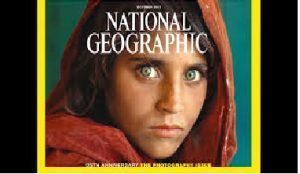
By: Akif Emre*
While the Afghan resistance continued with all its intensity in 1984, the mujahids fighting against Russia were considered as freedom fighters by the West, especially the US. The ideologies of the mujahids, their world-views, their religion, culture, and values not being compatible with the West wasn’t taken into consideration at all during that time. Theories on the “clash of civilizations” weren’t discussed as yet, and Islam and Islamic valued weren’t considered (or shown target) as opposing to the West’s universal values. But the stones that would finish the Cold War were being laid in Afghanistan.
Afghanistan, which is imposed as the land of “religious terrorists” was represented by a little girl’s feminine face asking for help and compassion. The girl on the cover of the National Geographic was also matched up with the image of the oriental female image. It can be said that, the National Geographic Magazine and, therefore, the National Geographic Society, which published this photo that represents ‘the West’s passion for invasion’ (as Sontag puts it) has a past of about a century. A magazine that seems scientific yet is rather ideological. It makes a mixture of human sciences from Anthropology to sociology and reflects the American view. In other words, this magazine is America’s camera turned towards the world.
The topics discussed in the magazine and their scripts are written and edited with the utmost care. But the images it uses is what actually makes this magazine different. It is selective both technically and perspectively. A photo is chosen amongst a hundred others, which represents American orientalism even through the lighting. Photos are disconnected from their historical and cultural backgrounds and are prepared for the taste and interests of the American reader. Moreover, these covers are like a road to exploration for the U.S., which has been interested in “opening up to the world.”
The story of the girl, whose photo was taken in 1984 when she was only 12, doesn’t finish there, of course. The image that was portrayed was a picture of an Afghani girl with green eyes, white complexion and feminine nature, who was probably descended from the Hellenic times of Alexander the Great. Through this, they tried to establish a connection between the West (especially the U.S.) and a country in the East holding Hellenistic genes. They were also laying the emotional and cultural foundations of the collapse of the Soviet Union, who was at war, or better said, in an arms competition with the U.S…
Years later, the Soviet Union would end its invasion, leaving Afghanistan in blood and tears, but destroying itself. The Cold War would finish, but Afghanistan would suffer a new occupation. Supporting the Afghani mujahids against the Russian occupation, the U.S. would then invade Afghanistan following the September 11, 2001 attacks. The “Afghani girl” would once again be on the cover of the National Geographic after the U.S. invasion of Afghanistan. McCurry and his crew, who had photographed the Afghani girl, found the girl once again and took her photo, yet this time the girl was a woman who had aged. This image was once again the cover of the Magazine. Despite all the sorrows she experienced, the Afghani girl with the green eyes had left her place to an Afghani woman with deep lines and tired eyes. Because, her country, which was the “land of terror and evil” was bombed by American planes and then occupied. This image of the woman then represented everything opposite to the universal values of the West.
And lastly, we heard the news that she was arrested by Pakistani police in the Peshawar region for holding a fake identity card.
And the latest news, that she was arrested in Pestun due to her fake identity card and the fact that this news was announced by news agencies to the world, is very strange.
If we were to continue the semiotic readings, Afghanistan is no longer an issue.
Putting the dramatic story that represents this issue aside, I would have to warn that the images and photographs used from the Middle East on the covers of magazines today are done intentionally…
*Akif Emre is a Turkish columnist. He writes for Yeni Şafak Turkısh daıly.
(Published in Yeni Şafak on Thursday 27, 2016)




